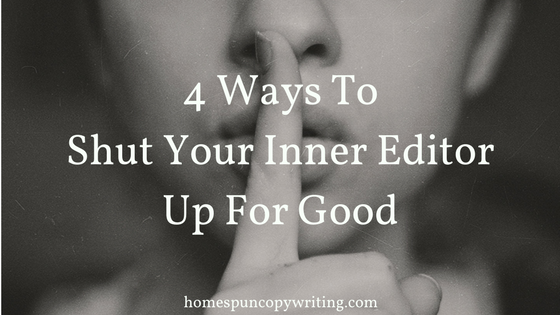4 Ways to Shut Your Inner Editor Up for Good
I’ve written before about the importance of silencing your inner editor when you’re trying to be productive. There’s nothing worse than sitting down to write the first draft of a piece of content and being stopped in your tracks by the (extremely blunt) voice in your head every time you find an error.
He tries to convince you that he’s helping, when in fact all he’s doing is stopping you from getting any productive work done (and yes my inner editor is a male because of course he is).
Learning how to control him is one of the best things you can do for your writing, so here are 4 tips on the best way to shut him up.
1. Don’t Read What You Wrote Yesterday
A lot of writers start their day by reading over what they wrote the day before, so as to get back into the mindset of whatever it is they’re writing about.
This is great for reminding yourself about the topic and about what you’ve already said, but it’s not great for trying to block out that inner editor. In fact, if anything it’s inviting him to start picking away at every detail.
By reading over what you’ve already written before starting to write again you’re inevitably going to find things wrong that you want to fix. But doing that just stops you from getting any more writing done, and if you’re halfway through a piece, then this is going to stop you from finishing it.
I’ve heard a few writers suggest that before you finish for the day, start a new sentence or paragraph that you can continue from the next day. That way you have a starting off point and you don’t have to go back over everything you’ve already done.
Other writers start a whole new document, pasting only the last line they wrote onto it and starting from there, again, getting rid of any urge to read anything else.
2. Leave Yourself Little Notes
There’s nothing worse than getting stuck on one word that doesn’t mean exactly what you want it to, or one sentence that isn’t structured perfectly. This is what your inner editor feeds on, and he’ll feast if given the chance.
So instead of wasting precious writing time agonising over these little things, leave a little note for yourself to go back to it once you’ve finished writing. I normally leave a little star beside the word, or write FIX or RESTRUCTURE in bold letters.
This calms the inner editor down a little as you’re still acknowledging the error, but you’re not spending too long trying to fix it to the detriment of the rest of your work.
3. Write Under Pressure
I don’t know about you, but I know I get some of my best work done when there’s a deadline looming. Nothing motivates me more than seeing that date circled on my calendar getting closer.
Now I am by no means saying you should leave all your work until the last minute. That’s risky and downright unprofessional. But what I am suggesting is that you recreate the conditions of a deadline to harness some of that motivational power.
A tool like Write or Die is perfect for this. It’s basically an app that you can type straight onto, but if you stop typing for a certain amount of time, it will start to delete what you’ve already written. If that’s not enough to keep you writing, then nothing is.
Basically, you’ll have no choice but to ignore your inner editor because if you start listening to him and questioning what you’re writing, you’ll lose everything.
4. Give Yourself Permission to Write Badly
This is probably the most important tip so listen up. Writing the first draft of something is about getting your ideas onto paper in some sort of vaguely coherent structure. It doesn’t have to be the best-written piece you’ve ever done because the editing process comes after. You just have to write so you have something to edit.
Your inner editor is the part of you that wants to be perfect, so once you realise that perfection isn’t the goal, you can go easier on yourself. Remember that practise makes perfect, so the more you write, the better you’ll get at those first drafts.
Perfection isn’t always good anyway. Mistakes are what help us learn and grow as writers.
Your inner editor is there to help, but sometimes he just needs to tone it down a bit especially for a first draft.
The most important thing is to get something down on paper. Then he can scrutinise all he wants and make sure that your writing is as good as it can be when you hit the publish button.



